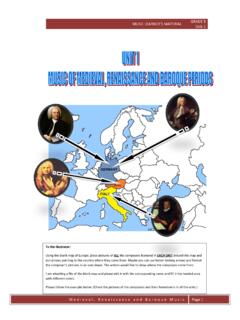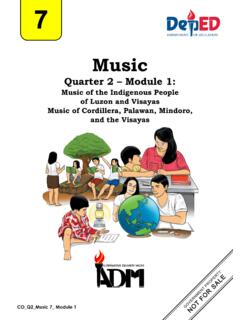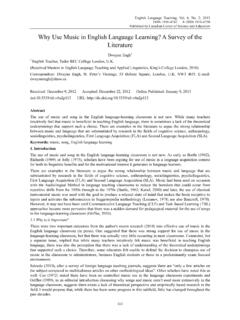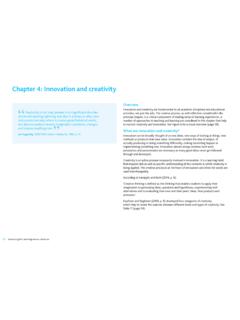Transcription of Grade 7 Learner’s Material
1 music Grade 7 Learner s Material (Units 1 and 2) 1 music LEARNING MODULE 1: music of Cordillera I TARGET Grade LEVEL: Grade 7 II MODULE 1: music of Cordillera III TIME ALLOTMENT: 2 Hours IV OVERVIEW OF THE MODULE The lesson is an overview on the music of the Cordillera, or the Highlands of Luzon, where several ethnolonguistic groups in the mountains of the Cordillera live. Through the lesson, one will discover how the Cordillerans express their feelings towards each other and the environment, their history, and their supernatural beliefs through the medium of the voice and/or musical instruments. A group performance inspired by examples of Cordillera music will culminate the educational experience. V PERFORMANCE STANDARD Analyzes musical elements and processes of Philippine music .
2 Correlates Philippine music to Philippine culture. Performs examples of Philippine music , alone and with others, in appropriate tone, pitch, rhythm, expression, and style. VI COMPETENCIES/OBJECTIVES Analyzes an example of Philippine music from the Highlands and Lowlands of Luzon, and describes how the musical elements are used. Explains the distinguishing characteristics of representative Philippine music from the Highlands and Lowlands of Luzon, in relation to history and culture of the area. Analyzes the relationship of functions of Philippine music from the Highlands and Lowlands of Luzon, to the lives of the people. Sings accurately representative songs from the Highlands and Lowlands of Luzon, alone and / or with others. Performs on available instruments music from the Highlands and Lowlands of Luzon, alone and / or with others.
3 Improvises simple rhythmic / harmonic accompaniments to selected Philippine music from the Highlands and Lowlands of Luzon. Explores ways of producing sounds on a variety of sources that would simulate the instruments being studied. Evaluates music and music performances by applying knowledge of musical elements and style. 2 VII CONTENT/TOPIC music of the Cordillera Vocal music Hudhud (chanted epic poetry) Instrumental music - Bamboo Stamping Tubes (Tongatong), Bamboo Pipes in a Row (Saggeypo), Bamboo Buzzers (Bungkaka), Bamboo Jew s Harp (Kubing), Patteteg (Bamboo Leg Xylophones), Gongs (Gangsa Topayya and Palook) Cultural Context (History and Traditions) Apayao, Bontok, Ibaloi, Ifugao, Kalinga, Tingguian Composition: Chanted Poetry, Songs (children s songs, lullaby, spirit songs, narrative legends), Dances Social Functions: music for Worship and Rituals, Work (Planting), Sleep, Courtship Performance Styles / Techniques VIII RESOURCES Readings: (with audios and videos already) (with audios and videos already) Maceda, Jose (1998).
4 Gongs and Bamboo. Quezon City: University of the Philippines Press. Recordings: Hudhud- Aliguyon the Animation : Hudhud hi Aliguyon (Hudhud chants of the Ifugao) : Mambayu- 1-17 Kalinga Mabayu (rice-pounding song) : Bagbagto- 1-16 Ibaloy Bagbagto (children s song) : Tongali- 1-03 Kalinga tongali (bamboo nose flute) : 3 Saggeypo- 1-11 Kalinga saggeypo (bamboo pipes in a row) Tongatong- 1-10 Kalinga tongatong (bamboo stamping tubes) : Bungkaka- 1-08 Kalinga bungkaka (bamboo buzzers) : Gangsa- 1-02 Kalinga gangsa topayya (flat gongs played with the hands) : 1-01 Kalinga gangsa pattung/palook (flat gongs played with sticks) : IX ACTIVITIES K-W-L Chart: Write what you currently know about the music of Cordillera under column 1 and what you want to know about the music of Cordillera under column 2.
5 music of Cordillera 1 Concept Map: Based on the contents of the readings and links given above, fill in the boxes below with details regarding the music of Cordillera. 4 What is the Hudhud to Me: My Own Hudhud: To describe the sound of the Hudhud, a chanted epic poetry, fill in the columns below in terms of the elements of music . Timbre dynamics rhythm pitch form As a group, create a poem of 8 lines. It may be about: love, honor, peace efforts or bravery . Compose a melody to your music of Cordillera 5 . Guide Questions for music Listening: Listen to the following instrumental music from the Cordillera region. Answer the following questions as you listen to them. You may also do some research: a. What instrument was used in this particular music ?
6 What is the function of the music in the society? b. Describe the instruments used. What is the instrument made of? How was it played? What instrumental substitutes can be used using environmental materials present in the classroom? c. How were the varied musical elements (timbre, dynamics, rhythm, pitch, form) employed bring about the message of the music ? X ASSESSMENT Rubrics for Group Performance Basic Unfocused tone, erratic rhythm, unstable pitch, inconsistent phrasing and dynamics. Needs work on nuances with reference to style and context. Developing: Focused tone but inconsistent in the extreme ranges, some repeated errors in rhythm , pitch and phrasing, discernible dynamic levels, some nuances as indicated in the music score or as suggested by the teacher with reference to style and context.
7 6 Approaching Proficiency: Focused and clear tone in the normal ranges, isolated errors in rhythm, pitch and phrasing, more obvious dynamic levels, with more nuances as indicated in the score or as suggested by the teacher with reference to style and content. Proficient: Focused and clear tone throughout the piece, accurate rhythm and secure pitch, consistent and sensitive phrasing, and well-defined dynamic levels, with creative nuances as indicated in the music score or as suggested by the teacher with reference to style and content. Rubrics for Designing an Instrument Substitute Basic: Inappropriate; Messy and incomplete materials; Sound quality lacks similarity with that of the original Developing: Most materials appropriate; Decorated but messy Neat but fragile; Sound quality somewhat similar but not exactly similar to that of the original instrument.
8 Approaching Proficiency: Appropriate materials; Decorated, neat; Sound quality almost similar to that of the original instrument Proficient: Appropriate and creatively modified materials; Decorated within the context of the instrument; Neat and Durable; Sound quality most similar to that of the original instrument. XI SYNTHESIS The music of the Highlands of Luzon (Cordillera) helps us discover the way of life of the Cordillera people through themes about nature, family life, work in the field as well as the spiritual matters. In addition to songs and chanted poetry, Cordillera music is distinctively made up of two sound characteristics of instruments based on their respective materials - the first, made of bamboo ( (flutes, percussion instruments), and the second, made of metal (gongs).)
9 These traditions are on their way to extinction due to the modernisation of the way of life among the youth of the Cordillera region. Less and less of the young generation are taught/learning the traditional music of their forefathers. Other threats to their music and most especially, their way of life are the conflict between state policies and their ancestral rights on land ownership, megatourism, militarization, and the shift from manual farming to machine-processed farming. Despite all these, several non-governmental organizations and international organizations like UNESCO ensure the protection not only of the rich culture and tradition of the Cordillera region but also of their people. 7 music LEARNING MODULE 2: music of the Lowlands of Luzon 1: music for Liturgy and Devotional music I TARGET Grade LEVEL: Grade 7 II MODULE 2: music of the Lowlands of Luzon 1 III TIME ALLOTMENT: 2 Hours IV OVERVIEW OF THE MODULE The lesson is an overview on the music of the Lowlands of Luzon, particularly on the music for Liturgy and Devotional music .
10 Through the lesson, one will discover how the people of the Lowlands of Luzon express their feelings towards each other and the environment, their history, and their religious beliefs through the medium of voice and musical instruments. A group performance inspired by the Lowlands musical examples will culminate the educational experience. V PERFORMANCE STANDARD Analyzes musical elements and processes of Philippine music . Correlates Philippine music to Philippine culture. Performs examples of Philippine music , alone and with others, in appropriate tone, pitch, rhythm, expression, and style. VI COMPETENCIES/OBJECTIVES Analyzes an example of Philippine music from the Highlands and Lowlands of Luzon, and describe how the musical elements are used. Explains the distinguishing characteristics of representative Philippine music from the Highlands and Lowlands of Luzon in relation to history and culture of the area.








